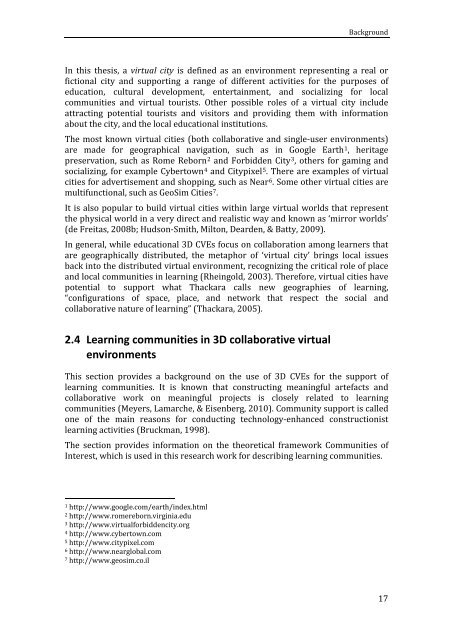Disputation Mikhail Fominykh - Department of Computer and ...
Disputation Mikhail Fominykh - Department of Computer and ...
Disputation Mikhail Fominykh - Department of Computer and ...
You also want an ePaper? Increase the reach of your titles
YUMPU automatically turns print PDFs into web optimized ePapers that Google loves.
Background<br />
In this thesis, a virtual city is defined as an environment representing a real or<br />
fictional city <strong>and</strong> supporting a range <strong>of</strong> different activities for the purposes <strong>of</strong><br />
education, cultural development, entertainment, <strong>and</strong> socializing for local<br />
communities <strong>and</strong> virtual tourists. Other possible roles <strong>of</strong> a virtual city include<br />
attracting potential tourists <strong>and</strong> visitors <strong>and</strong> providing them with information<br />
about the city, <strong>and</strong> the local educational institutions.<br />
The most known virtual cities (both collaborative <strong>and</strong> single-user environments)<br />
are made for geographical navigation, such as in Google Earth 1 , heritage<br />
preservation, such as Rome Reborn 2 <strong>and</strong> Forbidden City 3 , others for gaming <strong>and</strong><br />
socializing, for example Cybertown 4 <strong>and</strong> Citypixel 5 . There are examples <strong>of</strong> virtual<br />
cities for advertisement <strong>and</strong> shopping, such as Near 6 . Some other virtual cities are<br />
multifunctional, such as GeoSim Cities 7 .<br />
It is also popular to build virtual cities within large virtual worlds that represent<br />
the physical world in a very direct <strong>and</strong> realistic way <strong>and</strong> known as ‘mirror worlds’<br />
(de Freitas, 2008b; Hudson-Smith, Milton, Dearden, & Batty, 2009).<br />
In general, while educational 3D CVEs focus on collaboration among learners that<br />
are geographically distributed, the metaphor <strong>of</strong> ‘virtual city’ brings local issues<br />
back into the distributed virtual environment, recognizing the critical role <strong>of</strong> place<br />
<strong>and</strong> local communities in learning (Rheingold, 2003). Therefore, virtual cities have<br />
potential to support what Thackara calls new geographies <strong>of</strong> learning,<br />
“configurations <strong>of</strong> space, place, <strong>and</strong> network that respect the social <strong>and</strong><br />
collaborative nature <strong>of</strong> learning” (Thackara, 2005).<br />
2.4 Learning communities in 3D collaborative virtual<br />
environments<br />
This section provides a background on the use <strong>of</strong> 3D CVEs for the support <strong>of</strong><br />
learning communities. It is known that constructing meaningful artefacts <strong>and</strong><br />
collaborative work on meaningful projects is closely related to learning<br />
communities (Meyers, Lamarche, & Eisenberg, 2010). Community support is called<br />
one <strong>of</strong> the main reasons for conducting technology-enhanced constructionist<br />
learning activities (Bruckman, 1998).<br />
The section provides information on the theoretical framework Communities <strong>of</strong><br />
Interest, which is used in this research work for describing learning communities.<br />
1 http://www.google.com/earth/index.html<br />
2 http://www.romereborn.virginia.edu<br />
3 http://www.virtualforbiddencity.org<br />
4 http://www.cybertown.com<br />
5 http://www.citypixel.com<br />
6 http://www.nearglobal.com<br />
7 http://www.geosim.co.il<br />
17
















